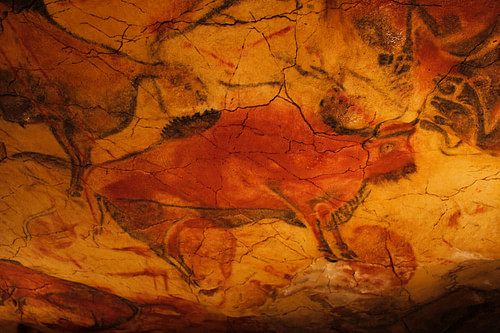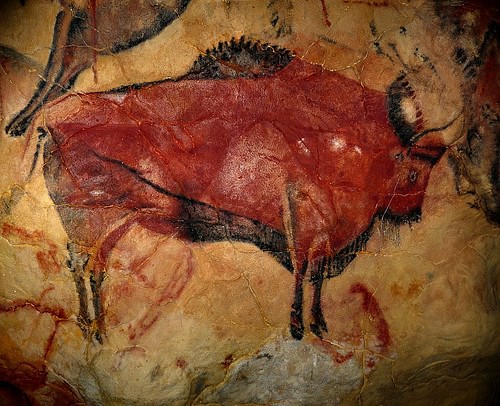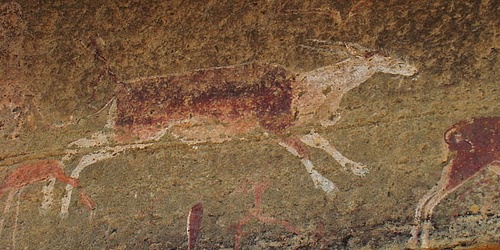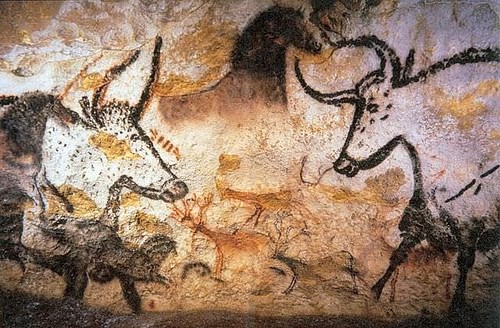Which of the Following Is True of the Interpretation of Upper Paleolithic Cave Art?
Rock art (also known as parietal art) is an umbrella term which refers to several types of creations including finger markings left on soft surfaces, bas-relief sculptures, engraved figures and symbols, and paintings onto a rock surface. Cave paintings, above all forms of prehistoric fine art, have received more attending from the academic research customs.

Paleolithic Cave Painting in Altamira Cave
Rock fine art has been recorded in Africa, the Americas, Asia, Commonwealth of australia, and Europe. The earliest examples of European rock art are dated to about 36,000 years ago, just information technology was not until around 18,000 years ago that European rock art actually flourished. This was the time post-obit the end of the Last Glacial Maximum (22,000-19,000 years ago) when climatic conditions were beginning to improve after reaching their most critical point of the Water ice Age. Upper Paleolithic rock art disappeared of a sudden during the Paleolithic-Mesolithic transition period, around 12,000 years ago, when the Ice Age environmental conditions were fading.
It has been suggested that in that location is a correlation between demographic and social patterns and the flourishing of rock art: In Europe, the rock art located in the Franco-Cantabrian region (from southeastern France to the Cantabrian Mountains in northern Espana) has been studied in great detail. During the late Upper Paleolithic, this surface area was an ideal setting for prolific populations of several herbivorous species and, consequently, a loftier level of human population could be supported, which is reflected in the abundance of the archaeological cloth found in the region. Yet, in recent years the geographic region in which Upper Paleolithic rock art is known has increased significantly.
Subsequently over a century of discussion almost the 'meaning' of rock art, no complete scholarship consensus exists, and several explanations have been proposed to account for the proliferation of this prehistoric art. What follows is a brief summary of some of the explanations that take been put forward to account for the meaning of European Upper Paleolithic rock art.
ANTHROPOLOGICAL STUDIES WORLDWIDE Ordinarily EMPHASIZE THE RELIGIOUS/SPIRITUAL ORIGIN OF ROCK ART.
Fine art for Art'south Sake
This is possibly the simplest of all theories most Upper Paleolithic rock art. This view holds that there is no real meaning backside this type of art, that it is nothing simply the product of an idle activity with no deep motivation behind it, a "mindless decoration" in the words of Paul Bahn. As simple and innocent as this view may sound, it has some important implications. Some late 19th- and early 20th-century scholars saw people in the Upper Paleolithic communities as brute savages incapable of being driven by deep psychological motivations, and they even rejected the thought that rock art could have any connection with religion/spiritual concerns or any other subtle motivation. This arroyo is not accepted today, simply it was an influential ane in the early years of archaeology.

Cave Painting in the Altamira Cave
Boundary Markers
Some scholars have claimed that rock art was produced as purlieus markers by different communities during the time when climatic conditions increased the competition for territory between Upper Paleolithic hunter-gatherer communities. Cavern art, according to this view, is seen every bit a sign of the ethnic or territorial divisions inside the different Upper Paleolithic human being groups circumstantial in a given area. Cave art was used equally a marker past hunting-gathering communities in order to indicate to other groups their 'right' to exploit a specific area and avoid potential conflicts. Michael Jochim and Clive Gamble have made very similar arguments: they proposed the idea that the Franco-Cantabrian region was a glacial refugium with such a loftier population density during the Upper Paleolithic that art was used as a social-cultural device to promote social cohesion in the face of the otherwise inevitable social conflict.
This argument is in line with demographic and social patterns during the Upper Paleolithic. More population density meant more competition and territorial awareness. However, this model has some flaws. Hatfield and Pittman note that this approach is not consistent with the stylistic unity displayed by some rock art traditions. David Whitley has observed that this argument is not merely filled with a dose of 'western bias.' only it also contradicts the fact that no ethnographic study provides back up for this claim. It could also exist said that if Upper Paleolithic groups increased their awareness of territoriality, it is reasonable to expect some sort of indication of this in the archaeological record, such as an increase of signs of injuries inflicted with sharp or blunt weapons in human remains, or other signs of trauma that could be linked to inter-grouping conflicts. Although in this case it is possible that if the art really helped to avoid conflict, no such signs would be detected.
Structuralist Hyphothesis
Past analyzing the distribution of the images in dissimilar caves, André Leroi-Gourhan suggested that the distribution of the cave paintings is non random: he claimed in that location is a structure or pattern in its distribution, sometimes referred to every bit a 'blueprint'. Virtually horses and bison figures were, co-ordinate to Leroi-Gourhan'southward studies, located in central sections of the caves and were also the virtually abundant animals, well-nigh 60% of the total. Leroi-Gourhan added that bisons represented female and horse male identity. He argued that some unchanging concepts relating to male and female identity were the basis of stone art. In the words of Paul Mellars:
Paleolithic fine art might be seen as reflecting some primal "binary opposition" in Upper Paleolithic society, structured (maybe predictably) effectually the oppositions between male and female person components of society (Mellars, in Cunliffe 2001: 72).
In add-on to studying the figurative art, Leroi-Gourhan also paid attention to the abstruse motifs and tried to explicate them within the context of the structuralist thought that was ascendant during his time in linguistics, literary criticism, cultural studies, and anthropology, specially in France. Structuralist thought claims that human cultures are systems that can be analyzed in terms of the structural relations among their elements. Cultural systems incorporate universal patterns that are products of the invariant structure of the homo mind: proof of this can be detected in the patterns displayed in mythology, fine art, religion, ritual, and other cultural traditions.

Cave Paintings in the Chauvet Cave
Initially, this explanation was very popular and widely accustomed by scholars. Nonetheless, when André Leroi-Gourhan attempted to fit the prove into his standard layout scheme, a correlation could not be proven. It also became axiomatic, as more stone art was discovered, that each site had a unique layout and it was not possible to employ a full general scheme that would fit all of them.
Although unsuccessful, the arroyo of André Leroi-Gourhan was influential. He also has some other important merit: at the time, structuralist thought was ascendant in many academic disciplines: by attempting a structuralist explanation of rock fine art, Leroi-Gourhan was seeking to show that Upper Paleolithic people were not ignorant savages simply were people with cerebral chapters, just similar people today.
Hunting Magic
Another proposition is that Upper Paleolithic rock art is a manifestation of sympathetic magic, designed as an assistance for hunting, in the words of Paul Mellars, to "secure command over particular species of animals which were crucially important human food supply". Some supporting evidence of this view includes the fact that sometimes the animals were apparently depicted with inflicted wounds, coupled with ethnographic analogy based on supposed similarities betwixt Upper Paleolithic art and Australian Aboriginal rock art. Magic rituals may not have a straight material outcome, but this type of practice surely boosts the conviction and has a directly psychological benefit (a form of placebo effect), increasing the success of hunting activities. In this context, Upper Paleolithic rock art is seen every bit a tool to magically benefit the groups' subsistence, encouraging the success of the hunters.
The ethnographic information indicating that magic plays a significant function in tribal life does not simply come from Australian Ancient groups. Other examples are plant amongst the native Kiriwina people who live in Papua New Guinea, where the levels of superstition and magic ceremonies ascension with the levels of uncertainty: when it comes to canoe building, for case, we read that magic
is used only in the instance of the larger sea-going canoes. The small canoes, used on the calm lagoon or near the shore, where there is no danger, are quite ignored past the magician (Malinowski 1948: 166, emphasis added).
This emphasizes the idea that magic can be a psychological response to conditions where doubt grows, which is what we would look in the example of hunters affected by increasing population pressure.
Shamanism
In this explanation, Upper Paleolithic fine art is the result of drug-inducing trance-like states of the artists. This is based on ethnographic data linked to San rock fine art in Southern Africa, which has some mutual elements with European Upper Paleolithic fine art.

San rock art
Lewis-Williams has argued that some of the abstract symbols are really depictions of hallucinations and dreams. The San religious specialists, or Shamans, perform their religious functions under a drug-induced state: going into trance allows them to enter into the 'spirit realm', and information technology is during this states that shamans claim to see 'threads of lights' which are used to enter and exit the spirit realm. When the homo encephalon enters into certain contradistinct states, bright lines are part of the visual hallucinations experienced by the individuals: this pattern is not linked to the cultural groundwork just rather a default response of the brain. Long, sparse reddish lines interacting with other images are nowadays in San rock paintings and are considered to be the 'threads of light' reported by the shamans, while the spirit realm is believed to exist behind the stone walls: some of the lines and other images appear to enter or exit from cracks or steps in the stone walls, and the paintings are 'veils' between this world and the spirit world.
This is another solid argument. Nonetheless, there is no basis to generalize the idea of shamanism equally the cause of European rock fine art as a whole. Shamanic practices could exist, at best, considered a specific variation of the religious and magical traditions. Shamans practice non create magic and religion; instead, information technology is the propensity for believing in magic and religion present in virtually every society that is the origin of shamans. Ultimately, this argument rests on magic and religious practices, non far from the statement that sees art as a form of hunting magic.
Conclusion
Since virtually all cultural developments have multiple causes, it seems reasonable to suppose that the evolution of the Upper Paleolithic has a multi-causal caption rather than a single cause. None of the arguments presented above can account fully for the evolution of Upper Paleolithic rock art in Europe.
Anthropological studies worldwide commonly emphasize the religious/spiritual origin of rock art. This is non the simply origin detected through ethnographic studies; there are examples of secular use, but it is plain the almost frequent. Nevertheless, information technology could besides be the case that art in the European Upper Paleolithic had a different pregnant from the communities that ethnographers have been able to study. Archaeology has been able to detect caves that may have been connected to rituals and magic at least in some Upper Paleolithic communities of Europe. Human burials were found in the Cussac cave associated with Paleolithic art: according to some authors, this stresses the religious/spiritual character of the rock art found in some caves.

Cave Painting in Lascaux
If the supposition that at least some European rock was created for religious reasons can be accepted, and so information technology is safe to suppose that rock art is just the most archaeologically visible evidence of prehistoric ritual and belief, and unless stone fine art was the merely and exclusive material expression of the religious life of prehistoric communities, we can assume that there is an entire range of religious textile that has not survived. Some of the Upper Paleolithic portable art could also be connected to religious aspects and be part of the 'material parcel' of prehistoric ritual.
Our noesis about the meaning of Upper Paleolithic stone and portable art should not be considered either correct or incorrect, just fragmentary. The chemical element of doubtfulness, which involves the rejection of any grade of dogmatic or simplistic explanation, is likely to e'er exist present in this subject. This should lead to flexible models complementing each other and the willingness to have that, as more evidence is revealed, arguments will take to be adjusted.
This article has been reviewed for accuracy, reliability and adherence to academic standards prior to publication.
hoseytheitheave1946.blogspot.com
Source: https://www.worldhistory.org/article/787/the-meaning-of-european-upper-paleolithic-rock-art/
0 Response to "Which of the Following Is True of the Interpretation of Upper Paleolithic Cave Art?"
Publicar un comentario